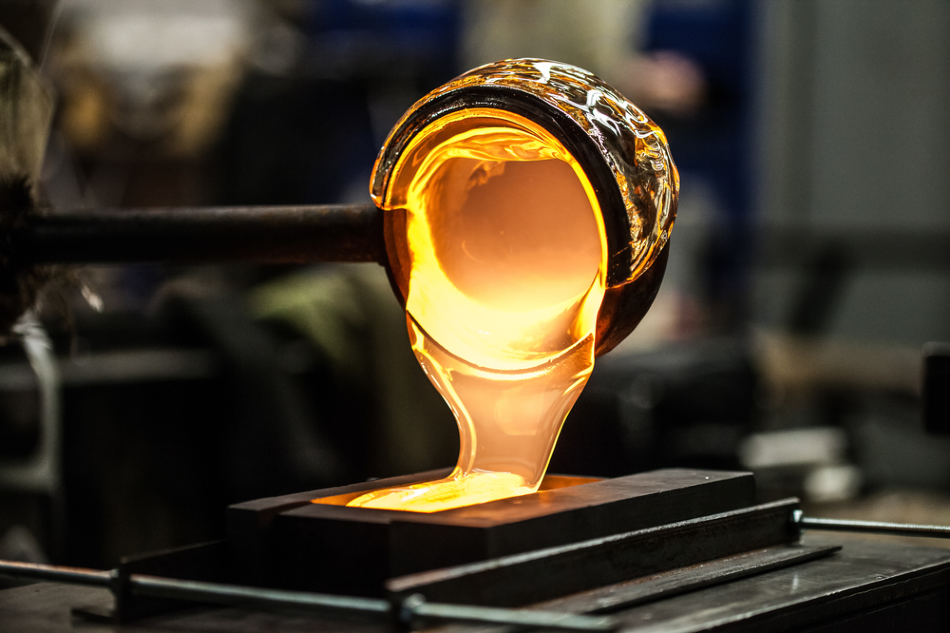Sponsored by Mo-SciJun 12 2020
What is Glass Viscosity?
Viscosity, a measure of a liquid’s fluidity, is measured through a substance’s resistance to motion under an applied force. Viscosity is also known as a fluid’s thickness. It is calculated by dividing shear stress (the force per unit area necessary to move one layer of fluid in relation to another) by shear rate (the measure of the change in speed at which intermediate layers move with respect to one another). The result is typically expressed in poise (P), which is equal to 0.1 Pa∙s (pascal second).

Image credit: Benoit Daoust | Shutterstock
Glass viscosity changes inversely with temperature. As it is heated, it flows more easily as the viscosity is reduced. This is due to the thermal energy produced causing the structural molecules to move more quickly and break the bonds between those molecules. As the temperature is reduced, viscosity increases, causing the structural bonds to re-form.
The relationship between viscosity and temperature is directly linked to the chemical composition of a glass. Manufacturers require methods to measure and model this relationship for a variety of glass compositions and temperatures. The viscosities of the majority commercial glasses such as soda lime and borosilicate are measured between 800 °C and 1400 °C.
Why is Glass Viscosity Important?
The viscosity of a glass has a substantial effect on other physical properties, such as melting, softening, and crystallization characteristics, as well as the pressure and temperature ranges within which the glass can be worked. Understanding the relationship between temperature and viscosity is vital in determining the right melting and heat treatment regimes in glass production and processing.
Manufacturers monitor viscosity and temperature throughout the manufacturing process so that they may find out how the glass will behave. For example, viscosity can directly impact refractory corrosion and the ability to homogenize a melt.
It is vital in the fining process to guarantee the batch chemicals are thoroughly melted and air bubbles are forced out. In addition, a glass’s viscosity grants manufacturers the ability to predict how the glass will perform in the glass forming process such as spheroidization, casting monolithic parts, or fiber generation.
Measuring Viscosity
The majority of viscometers work by comparing a moving object and a stationary fluid, or a stationary object and a flowing fluid. They measure the drag resistance during this movement. There are a variety of viscometers to choose from.
Parallel plate viscometers measure the rate of change in thickness of a cylindrical specimen between parallel plates moving perpendicular to their common central axis. This method is often used to measure the viscosity in the range of 105 to 108 Pa·s.
Rotation viscometers are typically employed to measure the viscosity in the range of 1 to 104 Pa·s. They use a platinum alloy spindle immersed in a crucible of molten glass. Spindle torque is measured and employed to calculate viscosity. The crucible can either rotate and the spindle is stationary; or it can be stationary while the spindle can rotate. Normally, data points are taken as a function of temperature to describe the viscosity curve for the glass.
Fiber elongation viscometers measure the elongation rate of a fiber of known dimensions under a known load. This method can be used for viscosities ranging from 105 to 1012 Pa·s and it is widely used to determine the Littleton softening and annealing reference points.
Falling sphere viscometers can be used to measure the viscosity in the range of 1 to 106 Pa·s. Falling sphere viscometers measure the time taken for a falling sphere of known density and radius to move between two points. This method uses principles from Stokes’s Law, which considers the drag force on a falling sphere.
Transformation range viscosities (108 to 1013 Pa·s) are frequently measured by the beam-bending method. Beam-bending is a method in which the rate of viscous bending of a simply loaded glass beam is measured over an extended length of time.
Glass Analytical Services from Mo-Sci
Mo-Sci can conduct a number of types of physical and chemical characterization on glass samples, including high-temperature viscosity measurements. Their fully equipped glass laboratories are set up to perform analytical tests for manufacturing, R&D, quality control and failure analysis. Mo-Sci also utilizes a large collection of standards against which the majority of glass samples can be measured and compared.
References
- The Physics Hyper-Textbook, Viscosity https://physics.info/viscosity/
- The Glass Packaging Institute, Viscosity https://www.glass-ts.com/services/temperature-viscosity
- https://www.gpi.org/what-glass
- Glassglobal Consulting, Glass properties https://www.glassglobal.com/consulting/reports/glass/properties.asp:
- Bright Hub Engineering, Types of Viscosity Measurement Devices https://www.brighthubengineering.com/fluid-mechanics-hydraulics/83996-viscosity-measurement-equipment/
- ASTM C965 - 96(2017), Standard Practice for Measuring Viscosity of Glass Above the Softening Point https://www.astm.org/Standards/C965.htm

This information has been sourced, reviewed and adapted from materials provided by Mo-Sci Corp.
For more information on this source, please visit Mo-Sci Corp.